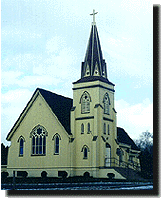
Two of Prince Edward Island’s most influential
creative minds are Robert Harris and William Critchlow
Harris, brothers who came to the Island as children when
their Anglo-Welsh family moved here from Bootle, England,
(near Liverpool) in 1856. The Harris brothers were very
close, sharing great mutual admiration, love, and
friendship. Both are buried with their family in St.
Peter’s Cathedral Cemetery in Charlottetown.
The younger and lesser known of the two is William
Critchlow Harris (1854–1913), a talented and
original High Victorian Gothic architect. With the
exception of two years spent in Winnipeg, Manitoba,
Harris worked and lived all his life in Prince Edward
Island and Nova Scotia. It is believed that his relative
obscurity and lack of recognition as an architect of
significance owes to his lack of travel. Harris’
designs are known for blending elements from a variety of
styles, combining them to create both beauty and function
in his buildings. Though he specialized in church design,
he also built many private residences, banks, and
business blocks that are still standing in Charlottetown
and throughout the Island, as well as in Nova Scotia.
Harris apprenticed as an architect
with David Stirling in Halifax, Nova Scotia for five
years beginning in 1870. Two years after his return to
Charlottetown, he established a cross-provincial
partnership with Stirling, opening an office in
Charlottetown. Perhaps his most spectacular and
well-known  building on Prince Edward
Island, the magnificent St. Mary’s Church in Indian
River was built in 1902. Numerous Critchlow structures in
Charlottetown include: the Kirk of St. James Presbyterian
Church, built with red Island sandstone in 1877; St.
Paul’s Anglican Church; business blocks on Victoria
Row; and Beaconsfield house on Kent Street. A musician in
his private life, Harris is known for designing his
churches to be not only beautiful and functional places
of gathering and worship but also giant musical
instruments, designed for optimal acoustics. St.
Mary’s Church in Indian River is especially renowned
for its acoustic purity and, as a result, has become a
recording studio for Island musicians and is the site of
annual summer music festivals.
building on Prince Edward
Island, the magnificent St. Mary’s Church in Indian
River was built in 1902. Numerous Critchlow structures in
Charlottetown include: the Kirk of St. James Presbyterian
Church, built with red Island sandstone in 1877; St.
Paul’s Anglican Church; business blocks on Victoria
Row; and Beaconsfield house on Kent Street. A musician in
his private life, Harris is known for designing his
churches to be not only beautiful and functional places
of gathering and worship but also giant musical
instruments, designed for optimal acoustics. St.
Mary’s Church in Indian River is especially renowned
for its acoustic purity and, as a result, has become a
recording studio for Island musicians and is the site of
annual summer music festivals.
Robert Harris (1849–1919) was a portrait painter,
among the best of his day. He is most famous for his
1883–34 piece depicting “The Fathers of
Confederation” at the 1864 Quebec Conference. This
painting is easily recognizable by most Canadians as it
is recreated in virtually every Canadian history book in
schools across the country. His oeuvre is all the more
admirable in the light of the artist’s delicate
eyesight. Harris financed his studies in Boston by
painting portraits of prominent Island citizens and
politicians. He often created these striking likenesses
from photographs and descriptions. Today, Harris’
paintings can be found in the Confederation Centre Art
Gallery and Museum’s permanent collection, which
holds thousands of his works, including small drawings in
sixty sketchbooks, landscape paintings, portraits, colour
sketches of the Fathers of Confederation painting, and a
large portrait of Canada’s first Prime Minister, Sir
John A. Macdonald. All Soul’s Chapel, Province
House, and Fanningbank (the lieutenant governor’s
residence) also display Harris pieces. Harris is also
recognized as one of the early presidents of the Royal
Canadian Academy.
Lest We
Forget | Islanders of
Valour | Women Who Served
Abroad
Musicians | Literature | Entertainers | Athletes
